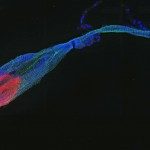Link to Pubmed [PMID] – 17148488
Nucleic Acids Res. 2006;34(22):6696-707
The human malaria parasite, Plasmodium falciparum, possesses a broad repertoire of proteins that are proposed to be trafficked to the erythrocyte cytoplasm or surface, based upon the presence within these proteins of a Pexel/VTS erythrocyte-trafficking motif. This catalog includes large families of predicted 2 transmembrane (2TM) proteins, including the Rifin, Stevor and Pfmc-2TM superfamilies, of which each possesses a region of extensive sequence diversity across paralogs and between isolates that is confined to a proposed surface-exposed loop on the infected erythrocyte. Here we express epitope-tagged versions of the 2TM proteins in transgenic NF54 parasites and present evidence that the Stevor and Pfmc-2TM families are exported to the erythrocyte membrane, thus supporting the hypothesis that host immune pressure drives antigenic diversity within the loop. An examination of multiple P.falciparum isolates demonstrates that the hypervariable loop within Stevor and Pfmc-2TM proteins possesses sequence diversity across isolate boundaries. The Pfmc-2TM genes are encoded within large amplified loci that share profound nucleotide identity, which in turn highlight the divergences observed within the hypervariable loop. The majority of Pexel/VTS proteins are organized together within sub-telomeric genome neighborhoods, and a mechanism must therefore exist to differentially generate sequence diversity within select genes, as well as within highly defined regions within these genes.

